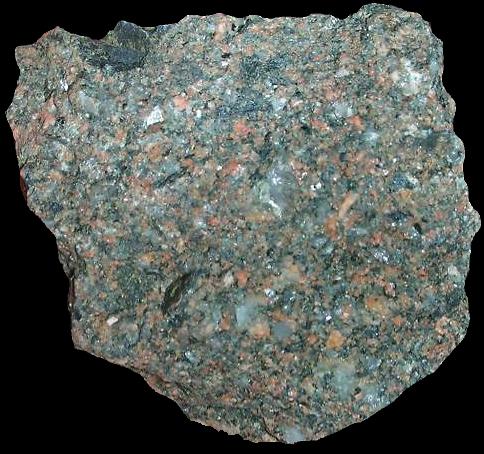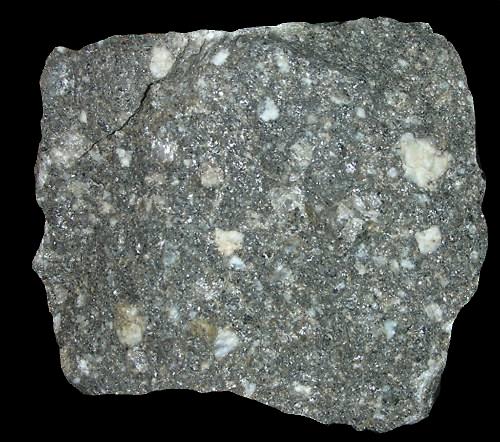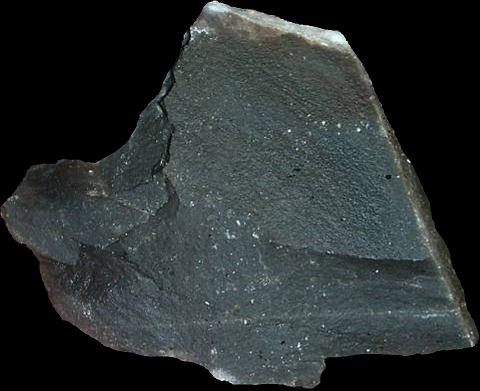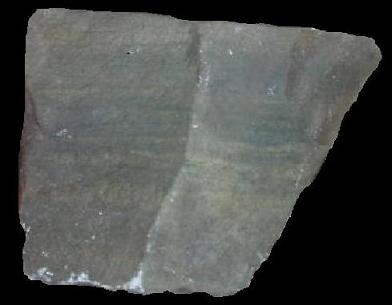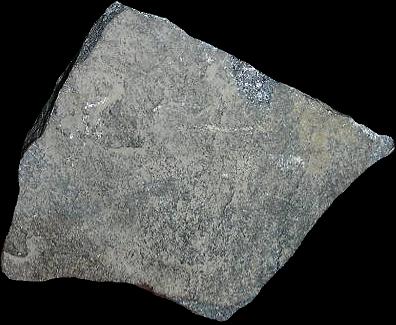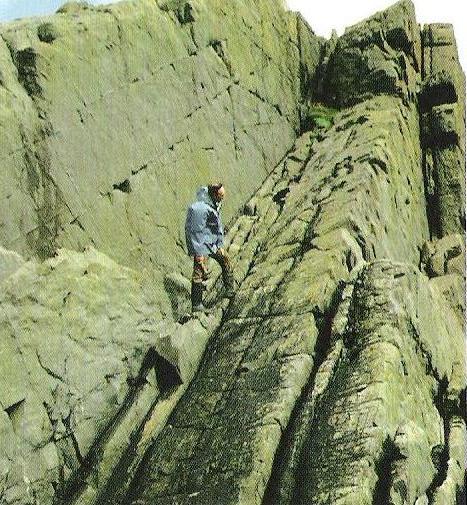Greywacke
Photographed by Michael P. Klimetz
MONTANA
Greywacke [or Graywacke] is a variety of sandstone generally characterized by its dark grey color, and poorly-sorted, angular grains of quartz, feldspar, and small rock fragments or lithic fragments set in a compact, fine-grained clay (or argillaceous) matrix. It is a texturally-immature sedimentary rock generally found in Palaeozoic age strata. The larger grains can be sand-to-gravel-sized, and matrix materials generally constitute more than 15% of the rock by volume. The term 'Greywacke' can be confusing, since it can refer to either the immature (rock fragment) aspect of the rock or the fine-grained (clay) component of the rock. The origin of greywacke was problematic prior to the understanding of turbidity currents and turbidites since, according to the normal laws of sedimentation, gravel, sand and mud should not be laid down together. Currently geologists attribute its formation to submarine avalanches or strong turbidity currents. These actions churn sediment and cause mixed-sediment slurries to occur. When this is the case, the rocks may exhibit a variety of sedimentary features. Support for the turbidity current origin is the fact that deposits of greywacke are found on the edges of the continental shelves, at the bottoms of oceanic trenches, and at the bases of mountain formational areas. It also occurs in association with black shales of oxygen-poor, deep sea origin. Greywackes are mostly grey, brown, yellow or black, dull-colored, sandy rocks which may occur in thick or thin beds along with slates and limestones. They are abundant in Wales, the south of Scotland, the Longford Massif in Ireland and the Lake District National Park of England, and compose the majority of the Alps of New Zealand. They can contain a very great variety of minerals, the principal ones being quartz, orthoclase and plagioclase feldspars, calcite, iron oxides and graphitic, carbonaceous matter, together with (in the coarser kinds) fragments of such rocks as felsite, chert, slate, gneiss, various schists, and quartzite. Among other minerals found in them are biotite and chlorite, tourmaline, epidote, apatite, garnet, hornblende and augite, sphene, and pyrite. The cementing material may be siliceous or argillaceous, and is sometimes calcareous. As a rule, greywackes are not fossiliferous, but organic remains may be common in the finer interbedded layers. Their component particles are usually not very rounded or polished, and the rocks have often been considerably indurated by recrystallization, such as the introduction of interstitial silica. In some districts the greywackes are cleaved, but they show phenomena of this kind much less perfectly than the slates. Some varieties include feldspathic greywacke, which is rich in feldspar, and lithic greywacke, which is rich in tiny rock fragments. Although the group is so diverse that it is difficult to characterize mineralogically, it has a well-established place in petrographical classifications because these peculiar composite arenaceous deposits are very frequent among Silurian and Cambrian rocks, and are less common in Mesozoic or Cenozoic strata. Their essential features are their gritty character and their complex composition. By increasing metamorphism, greywackes frequently pass into mica schists, chloritic schists, and sedimentary gneisses
Photographed by Michael P. Klimetz
MONTANA
Photographed by Michael P. Klimetz
Proterozoic
Wausau/Brokaw Area
WISCONSIN
Photographed by Michael P. Klimetz
Proterozoic
Wausau/Brokaw Area
WISCONSIN
Photographed by Michael P. Klimetz
MONTANA
Image Courtesy of the British Geological Survey
Outcrop of Tilted Greywacke Beds
Photographed by Michael P. Klimetz
Proterozoic
Marathon County
WISCONSIN
Photographed by Michael P. Klimetz
Proterozoic
Marathon County
WISCONSIN
Photographed by Michael P. Klimetz
Proterozoic
Marathon County
WISCONSIN
Photographed by Michael P. Klimetz
Ordovician
Grafton
Rensselaer County
NEW YORK
Photographed by Michael P. Klimetz
Ordovician
Grafton
Rensselaer County
NEW YORK
Photographed by Michael P. Klimetz
Ordovician
Grafton
Rensselaer County
NEW YORK
Photographed by Michael P. Klimetz
Ordovician
Grafton
Rensselaer County
NEW YORK
Photographed by Michael P. Klimetz
Ordovician
Grafton
Rensselaer County
NEW YORK
